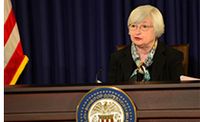
In recent speeches, the Federal Reserve’s Janet Yellen and Lael Brainerd explained how policymakers are likely to take a cautious approach to normalizing monetary policy given historically low estimates for the natural rate of interest and expectations that the rate will rise only gradually over time.
For background on the concepts they discuss, readers may want to check out numerous posts in the Liberty Street Economics archive covering the measurement and dynamics of the natural rate of interest as well as its use as a benchmark for calibrating monetary policy settings.
While the natural rate is unobservable, it is estimated using a variety of statistical and model-based approaches as the rate that both allows the economy to expand in line with its underlying potential and keeps inflation stable. As our bloggers explain, monetary policy can be seen as easy if the policy rate is below the natural rate, with the gap between the rates measuring the extent of the policy stimulus.
In a May 2015 post, Marco Del Negro and coauthors described how the New York Fed uses a dynamic stochastic general equilibrium (DSGE) model to calculate this hypothetical rate. The Bank’s estimates tracked the natural rate from above 6 percent in 2007 to -2 percent in mid-2009 to just above zero in May 2015. The authors also explained how the model helps to gauge the impact of shocks on the natural rate, both in history and in forecasts, as they answer the question “why are interest rates so low?”
In another post, Bianca De Paoli and Pawel Zabczyk delve into how factors related to risk and uncertainty might depress the natural interest rate. Those are dimensions that standard models leave out, and whose omission might lead to a policy rate that undershoots or overshoots its appropriate level, they said.
We use the blog periodically to present the updated economic forecast implied by the New York Fed’s DSGE model. See our latest estimate of the nominal natural rate of interest charted against the path of the nominal federal funds rate in a December post. The model continues to project a gradual increase in the natural rate as economic “headwinds” brought about during the financial crisis abate.
Stepping back, our bloggers have also explained how we share analysis such as the staff’s view of the level of the equilibrium rate and its anticipated dynamics with the Bank’s president in preparation for Federal Open Market Committee meetings.
Selected Posts
Why Are Interest Rates So Low?
Marco Del Negro, Marc Giannoni, Matthew Cocci, Sara Shahanaghi, and Micah Smith
Risk Aversion and the Natural Interest Rate
Bianca De Paoli and Pawel Zabczyk
The FRBNY DSGE Model Forecast—November 2015
Marco Del Negro, Marc Giannoni, Erica Moszkowski, Sara Shahanaghi, and Micah Smith
The Monetary Policy Advice Process at the New York Fed
Jamie McAndrews, Jonathan McCarthy, Paolo Pesenti, Argia Sbordone, and Andrea Tambalotti
Disclaimer
The views expressed in this post are those of the author and do not necessarily reflect the position of the Federal Reserve Bank of New York or the Federal Reserve System. Any errors or omissions are the responsibility of the author.
Anna Snider is a cross-media editor in the Federal Reserve Bank of New York’s Research and Statistics Group.










 RSS Feed
RSS Feed Follow Liberty Street Economics
Follow Liberty Street Economics